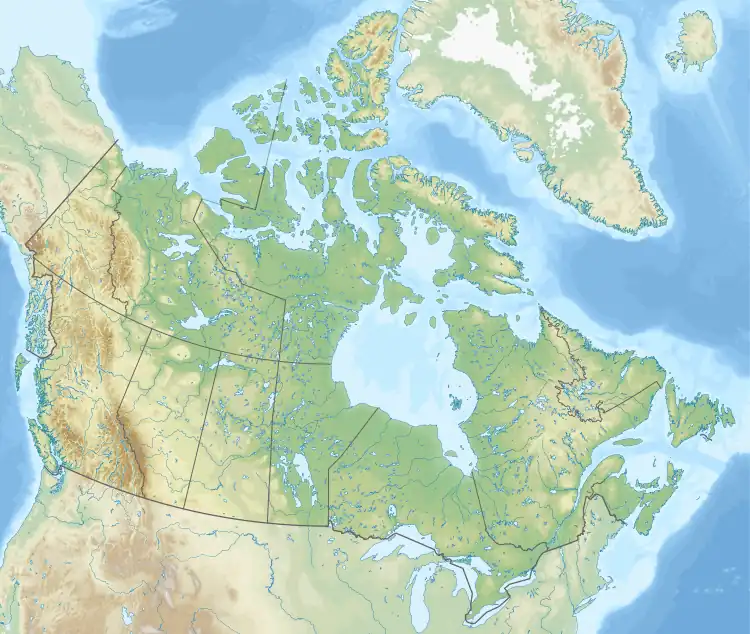| Whitesaddle Mountain | |
|---|---|
 Northeast aspect, from Bluff Lake | |
| Highest point | |
| Elevation | 2,990 m (9,810 ft)[1][2] |
| Prominence | 615 m (2,018 ft)[1] |
| Parent peak | Blackhorn Mountain (3,022 m)[3] |
| Isolation | 4.9 km (3.0 mi)[1] |
| Listing | Mountains of British Columbia |
| Coordinates | 51°38′21″N 124°50′54″W / 51.63917°N 124.84833°W[4] |
| Geography | |
 Whitesaddle Mountain Location in British Columbia  Whitesaddle Mountain Whitesaddle Mountain (Canada) | |
| Country | Canada |
| Province | British Columbia |
| District | Range 2 Coast Land District |
| Parent range | Coast Mountains Niut Range[1] |
| Topo map | NTS 92N10 Razorback Mountain[4] |
Whitesaddle Mountain is a summit located in British Columbia, Canada.
Description
Whitesaddle Mountain, elevation 2,990-meters (9,810-feet), is situated 300 km (190 mi) north-northwest of Vancouver in the Niut Range of the Coast Mountains. Whitesaddle ranks as the ninth-highest peak in the Niut Range.[1] Precipitation runoff and glacier meltwater from the mountain drains into tributaries of Mosley Creek, thence Homathko River and ultimately Bute Inlet. Topographic relief is significant as the summit rises nearly 2,200 meters (7,218 feet) above Middle Lake in six kilometers (3.7 miles).
History
The Whitesaddle name was submitted for consideration in April 1933 by Henry Snow Hall (1895–1987), Harvard Mountaineering Club, following his first ascent of nearby Blackhorn Mountain in 1932.[5] Hall wrote: "I have suggested the names Whitesaddle and Blackhorn for the two peaks which are prominently visible down the Homathko valley from the automobile road passing Tatla Lake. The names seem appropriate for this cattle ranching country because of the appearance of the peaks themselves. The right hand peak of the two, a dark rock dome, has a white glacier flowing from the summit down the face of the peak toward the observer which reminded me at once of a white saddle." The landform's toponym was officially adopted January 9, 1934, by the Geographical Names Board of Canada.[4]
The first ascent of Whitesaddle's summit was made in 1939 by Henry Snow Hall and Hans Fuhrer.[6] In July 1985, Fred Beckey and Reed Tindall were the first to climb the north face.[7]

Climate
Based on the Köppen climate classification, Whitesaddle Mountain is located in the marine west coast climate zone of western North America.[8] Most weather fronts originate in the Pacific Ocean, and travel east toward the Coast Mountains where they are forced upward by the range (Orographic lift), causing them to drop their moisture in the form of rain or snowfall. As a result, the Coast Mountains experience high precipitation, especially during the winter months in the form of snowfall. Winter temperatures can drop below −20 °C with wind chill factors below −30 °C.
See also
References
- 1 2 3 4 5 "Whitesaddle Mountain, British Columbia". Peakbagger.com. Retrieved 2022-12-26.
- ↑ BC Basemap topographic map
- ↑ "Whitesaddle Mountain, Peakvisor.com". Retrieved 2022-12-26.
- 1 2 3 "Whitesaddle Mountain". Geographical Names Data Base. Natural Resources Canada. Retrieved 2022-12-26.
- ↑ "Whitesaddle Mountain". BC Geographical Names. Retrieved 2022-12-26.
- ↑ Chic Scott (2000), Pushing the Limits: The Story of Canadian Mountaineering, Rocky Mountain Books, ISBN 9780921102595, p. 153.
- ↑ Fred Beckey (1986), Whitesaddle Mountain, North Face, Americanalpineclub.org
- ↑ Peel, M. C.; Finlayson, B. L.; McMahon, T. A. (2007). "Updated world map of the Köppen−Geiger climate classification". Hydrol. Earth Syst. Sci. 11. ISSN 1027-5606.
External links
- Weather forecast: Whitesaddle Mountain
- Henry Snow Hall in memoriam: Americanalpineclub.org